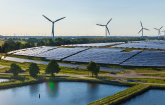Great River Energy and The Brattle Group Present Innovative Approach for Compliance with EPA Greenhouse Gas Regulations
CAMBRIDGE, Mass., Feb. 5, 2014 /PRNewswire/ -- Working with Minnesota-based Great River Energy, Brattle Group economists developed a regional market-based approach to implement EPA's forthcoming rule under Section 111(d) of the Clean Air Act to regulate greenhouse gas emissions from existing power generating sources ("Existing Source Rule"). The approach uses existing energy market infrastructure to achieve emission reduction targets while ensuring reliability and minimizing cost impacts.
The foundation of the proposed approach involves a three-step process of (1) translating greenhouse gas emissions reduction targets expected to be proposed by EPA this year in the Existing Source Rule into targets for regional power markets of independent system operators (ISOs), (2) meeting the required emissions reductions by applying an ISO-administered carbon price to electric generation in the market, and (3) refunding the carbon revenues collected through the carbon price to load serving entities based on consumption levels.
The new proposed approach would allow states within a regional power market to commit to meeting the regional targets, as opposed to setting state- or plant-specific caps on greenhouse gas emissions. This would be accomplished by charging a carbon price to electric generating units that will be collected by the ISO and will affect the order of dispatch of generating units in the market. At first, the carbon price needed to achieve the targeted regional reductions would be estimated. As experience is gained, the emissions can be compared to targeted levels and the selected carbon price can be adjusted periodically.
Great River Energy, which originated the concept and retained The Brattle Group to analyze and refine it, is actively exploring the idea with state and federal agencies and other stakeholders. Great Plains Institute has also been a partner in the exploration of the concept and is helping facilitate outreach to public and private stakeholders to further develop the details of the approach.
Jon Brekke, Vice President of Membership and Energy Markets at Great River Energy, noted that: "One of the major benefits of this approach is that we can leverage an established ISO and all of its infrastructure, while allowing the market to internalize the new constraints as the ISO optimizes the regional system dispatch. This way, we are complying with the regional greenhouse gas emissions constraint while simultaneously continuing to ensure system reliability and the lowest costs to consumers."
By adding appropriate carbon prices to the bids of individual generators, lower carbon-emitting resources will be dispatched more frequently (re-dispatch) than higher carbon-emitting resources and also will enjoy higher energy margins. The carbon price would also be reflected in wholesale prices, which would send an efficient price signal to both buyers and sellers in the wholesale power market. "This will lead to lower emissions in the short run (due to re-dispatch) and to a changing generation mix through entry and retirement over time, an outcome sought by the EPA," added Judy Chang and Jurgen Weiss, Brattle Group principals and the co-authors of the proposal.
Under the proposed approach, the ISO would charge carbon-emitting power plants a rate per ton of CO2 emissions. Plants with higher CO2 emissions would face a higher charge per megawatt-hour produced. In return, the charges collected would be refunded back to consumers through the load-serving entities, thereby limiting the initial cost impacts on consumers.
According to Brekke, Chang, and Weiss, the proposed approach has advantages over state- or plant-specific implementation of the Existing Source Rule because it:
- Uses the existing market structure to determine least-cost compliance solutions on a regional level.
- Automatically takes into account factors affecting compliance costs, such as operational constraints of plants, transmission congestion, and the timing and magnitude of previous investments and retirements.
- Minimizes the impact on end-user customers by fully refunding carbon charges imposed on generators.
- Leaves compliance-related investment decisions in the hands of market participants, thereby stimulating innovation and further reducing total compliance costs.
The Brattle Group is currently developing important design elements to implement the proposed approach. The most critical elements will be determining the regional target for CO2 emissions and estimating the initial carbon prices necessary to meet that target. Implementation in a regional market would require a broad stakeholder process of utilities and associated states to develop the necessary agreements.
A presentation summarizing the proposed approach is available for download at www.brattle.com. For further questions and comments, please contact Judy Chang ([email protected]) or Jurgen Weiss ([email protected]).
Great River Energy, based in Maple Grove, Minnesota, is a not‐for‐profit electric generation and transmission cooperative serving the wholesale power needs of 28 member distribution cooperatives (members). Through its members, Great River Energy supplies electric energy to approximately 650,000 customers in Minnesota and a small portion of western Wisconsin.
The Brattle Group provides consulting services and expert testimony in economics and finance to corporations, law firms, and public agencies worldwide. Areas of expertise include regulation, operations, and planning in network industries; antitrust and competition; valuation and damages; and utility regulatory policy and ratemaking. For more information, please visit www.brattle.com.
Great Plains Institute is a non-partisan, non-profit organization that works with diverse interests to transform the way we produce, distribute, and consume energy to be both environmentally and economically sustainable.
SOURCE The Brattle Group
WANT YOUR COMPANY'S NEWS FEATURED ON PRNEWSWIRE.COM?
Newsrooms &
Influencers
Digital Media
Outlets
Journalists
Opted In





Share this article